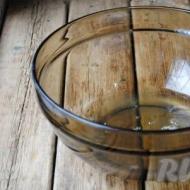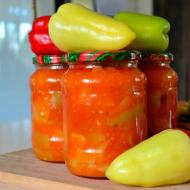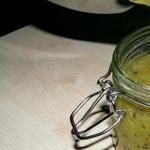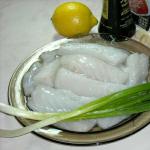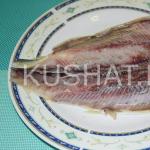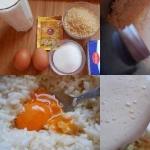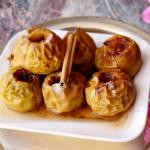
Japanese cake made from three ingredients in a slow cooker. Japanese style cakes to order. Making Japanese Strawberry Cake
The ability to quickly prepare dessert is always highly appreciated by housewives. As a rule, we are talking about cookies or muffins. However, there is a Japanese cake that requires you to have only three ingredients. You can prepare it very quickly. This cake is very tasty and goes perfectly with tea or fruit juice.
What kind of cake is this?
This Japanese cake became widely known after it appeared on screen in the film Chihiro's Journey. In it, the characters take part in a tea party with this dessert.
To make such a dessert, you will only need one thing: follow the recommendations below exactly, without skipping anything, and in the same order in which they are indicated. Additionally, you do not need to add any other ingredients at your discretion. If you don't do this, the result will not be very good.
Before you start learning the Japanese cake recipe, you should know that this dessert can be made in different ways. This means that you can add more ingredients, but the result will be the same. Including some additional ingredients in the dough can make the cake more “spongy”, but this effect can be achieved with the basic recipe.
What will you need?
Even if you don't like Asian movies and didn't know about this fact, it's still worth trying to make this Japanese cake. The recipe with a photo of this dessert is presented below. This is done very easily and simply, and you only need three products:
- 120 grams of white chocolate;
- 120 grams of soft cheese, such as Philadelphia;
- 3 eggs.
How to cook it?
This is a step-by-step recipe for a Japanese cake. Take 120 grams of white chocolate and place it on the stove to melt in a double boiler.
The essence of this procedure is to put a pan of water on the fire and place another container inside it in which you place the ingredients that need to be melted.

Be careful when doing this. Water is chocolate's worst enemy, so be very careful to make sure not a single drop gets into the pan filled with chocolate. Otherwise, it will curl and spoil all the results.
When you fill the first pot with water, do not fill it to the top. Fill it just over half to three quarters, and when you put the second pan in, the water should cover the outside of the pan without overflowing.
Please note that when the water starts to boil, it may end up in the second container. Therefore, constantly monitor the cooking process. When you start to see bubbles on the surface, pour out some of the water so it doesn't mix with the chocolate.
How to prepare chocolate
Break up the chocolate bar and place it in the second pan, and once it has melted, stir it with a spatula or spoon.
If creating a water bath seems too complicated for you, or if you don't have enough pans or pots of different sizes to do it, there is another way to melt chocolate. This is the application of a microwave oven. How to do this?
Break the chocolate into pieces, place it in a deep plate or bowl and put it in the microwave for 15-20 seconds. Every 15-20 seconds, open the microwave and check its condition. You should use a spoon to stir the melted slices. It may be that even after two or three heatings the chocolate may not seem to have changed shape, but when stirred it will be soft.
How to mix with other ingredients
After the chocolate has melted, add softened cheese (Philadelphia or similar) and mix well. You should get a completely homogeneous mass of one color.

Set the mixture aside to allow it to cool slightly. At this time, take three eggs. Separate the yolks from the whites and place them in different cups. Place in the refrigerator to keep them cool.
You should separate the whites from the yolks so that the latter do not burst and so that the ingredients cannot mix. This is done as follows. Tap the shell with a knife approximately in the middle, make a break and divide the egg into two halves. In this case, part of the protein will fall into your hand. Hold your hand like a spoon over the bowl, fingers slightly apart, and then transfer the egg from one hand to the other. Do this without sudden movements so that the yolk is not damaged. Repeat this step until the whites have completely drained out. This will leave you with a soft and perfectly round yolk between your fingers. Continue this same procedure with the other eggs and be sure to refrigerate the whites.
Add the yolks to the chocolate and cheese mixture you prepared earlier. Mix well until all ingredients come together. Do not beat the mixture too hard, otherwise you will create foam, which will disrupt the cooking process.
Once the ingredients are completely mixed, preheat the oven to 170ºC. Now keep the mixture aside and take a springform pan. Grease the inside with butter or sunflower oil or place baking paper inside. Do not use margarine, it will not make the Japanese cake as tasty. Do not add flour or starch to the pan, this is not necessary.
How to add proteins?
Then remove the whites from the refrigerator and beat them until stiff peaks form. You can do this with an electric or portable whist. You can also use a pocket whisk, but it will be too difficult. Be prepared for the fact that your arm may hurt from tension. You need to whisk it quickly and vigorously. You can pause this process to recuperate and rest a bit, but then continue cooking at the same pace to form stiff peaks.
How do you know when you have reached this consistency? If you turn the bowl of egg whites upside down, they will not leak out.

Once the whites are beaten, add a quarter of the whipped mixture to the yolks, chocolate and cheese mixture and mix thoroughly in eight movements so that the whites do not fall off. Then add the remaining three-quarters and continue mixing with slow and steady movements.
How to bake it
Once all the preparatory process is over, it is time for the most important part. Pour warm water into the baking tray on which you will place the pan in the oven. The liquid level should be two fingers deep.
This is really very important. If you do not prepare a water bath for the dough, the Japanese cake will not turn out. The prepared cake will fall off and crack, and, in addition, will become too dense and tough.

When you pour water into the pan, place the pan with the dough on it and put it in the oven.
Correctly calculating the cooking time is also very important. If you bake it too long, your dessert will be rock hard and dense. If the cooking time is short, the cake will remain raw inside. That is why it is important to pay attention to this aspect.
So, how to bake a Japanese three-ingredient cake?
- First bake it at 170 ºC for 15 minutes.
- Then reduce the temperature to 160 ºC and leave to cook for another 15 minutes.
- After this, turn off the oven and leave the cake in it for an additional 15 minutes.
Finally, when the additional time with the oven turned off has expired, remove the dessert and leave it to cool. Do not attempt to remove the cake from the springform pan before it has cooled. Otherwise, it will break and you will end up with separate pieces glued to the base and edges. You should wait at least 40 minutes. In this case, the completely cooled dessert can easily be placed on a plate or serving dish. Now cut the cake into portions and serve.

What else should you keep in mind?
According to reviews of the Japanese three-ingredient cake, when preparing it you should adhere to the following rules:
- Try to use medium sized eggs rather than small or large ones. If you use too small ones, the mixture will be very thick, and if you use large ones, it will become runny and the cake will not turn out well.
- It is best to take Philadelphia as the best cheese, because the product of this brand has a specific pleasant taste. But if you can't get it, you can use any brand. Either way, you will still get the same result and the dessert will be delicious.

- Never forget to pour water on the baking sheet before placing it in the oven. This is the most important aspect in the cooking process for the cake to become fluffy. As for the shape, do not use containers into which water can leak.
How to decorate dessert?
If desired, you can sprinkle the dessert with coarse confectioner's sugar or powdered sugar and lay slices of berries and fruits over the entire surface. The Japanese strawberry cake looks especially good.
Ingredients: for biscuit:
Glucose - 10 g,
Eggs - 3 pcs.
Brown sugar - 60 g,
Wheat flour - 60 g,
Salt is on the tip of a knife,
Vanilla extract - 1 teaspoon,
Corn oil - 45 g;
for cream:
Cream 35% - 200 g,
Sugar - 1 tbsp. spoon,
Vanilla extract – 1/4 teaspoon,
Strawberries - 300 g.
Making Japanese Strawberry Cake:
Place glucose, eggs, sugar in a blender or mixer bowl. Start whipping, increase the speed not immediately, but gradually. When stirring, it will become noticeable that the mass has increased in size. When this happens, you need to take the flour, sift it and start adding it to the resulting composition. It must be added gradually. Carefully add some of the flour, slowly, and mix by hand with a whisk.
Then add the second part of the flour and mix again. Then add salt, again, knead by hand. Next, slowly pour vanilla and oil into the resulting mixture. Mix again by hand and slowly. Then take the blender bowl and tap it with a spoon; this action will cause air bubbles to come out of the mixture.
Preheat the oven to 175 degrees. The baking dish should be round. Cover the form with parchment and pour the resulting dough into it. Place the pan in the oven on the bottom shelf. Place an empty baking sheet on top. If you don’t do this, the cake will not be even. Initial baking time is 20 minutes. Then remove the empty baking sheet and bake for another 10 minutes.
When the time is up, remove the sponge cake and cool for 10 minutes.
During this time you need to prepare the cream. To do this, thoroughly beat the cream, sugar and vanilla extract.
When the cake has cooled, cut it so that you get two equally round cakes. Then apply cream to the first cake layer. Cut the strawberries into halves and place around the perimeter of the cake. Place the second cake layer on top of it, spread cream on top, coat the sides too and decorate again with strawberries.
Japanese strawberry cake is ready!
I won't intrigue you, these three ingredients are cream cheese, eggs and chocolate. No cookies, butter or cream included. Japanese minimalism in action!
Having cooked it at home for the first time, I didn’t think for a minute about what to make from it - of course, Japanese cheesecake! Fortunately, there is always a bar of chocolate and a few eggs in the house. But he doesn’t need more than that. Just three ingredients and a little patience while the cheesecake simmers in the oven - that’s all that separates you from this airy, incredibly tender and aromatic delicacy! Shall we begin?!
Prepare your ingredients.
Cream Cheese: Any unflavored cream cheese will work. I used homemade cream cheese from kefir. So the cheesecake turned out to be even more dietary than when using classic cream cheese - only 129 kcal/100 g (calorie content of cheese is given).
Chocolate: high-quality white chocolate without additives. The chocolate in this dish is both a flavoring and a sugar substitute, so choose the chocolate that tastes good to you on its own.
Chicken eggs: the final volume and size of the cheesecake depends on the number of eggs used. For each egg there should be 40 grams of cream cheese and chocolate. Based on these proportions, the number of components can be reduced or increased, accordingly changing the size and volume of the cheesecake.

Melt the chocolate in a microwave oven or in a water bath.

Separate the yolks from the whites.

Mix melted chocolate and cream cheese.

When the mixture has cooled slightly, stir in the yolks one at a time.
Be sure to add the yolks to the slightly cooled mixture. If the mixture is too hot, the yolks will curdle and the cheesecake will taste like an egg omelet.

Beat the egg whites with a pinch of salt until stiff peaks form.

Fold the whipped whites into the main mixture in batches, stirring from bottom to top to maintain their fluffy texture.

Grease one side of baking paper with a small amount of vegetable oil. Line the sides and bottom of the baking dish with baking paper, “sticking” it with the buttery side to the surface of the form.
Pour the mixture into the mold.

Place the pan in a larger container or baking dish. Fill it with warm water so that the cheesecake pan is halfway submerged in water.
Bake a three-ingredient Japanese cheesecake in an oven preheated to 170 degrees for 15 minutes. Then another 15 minutes at a temperature of 160 degrees. Turn off the oven and leave the cheesecake in the cooling oven for the next 15 minutes.
I used a ceramic baking dish, so I placed the cheesecake in a cold oven, increasing the first baking period by 10 minutes. I immediately covered the pan with foil and only removed it for a few minutes at the end of baking to brown the top of the cheesecake.

Remove cheesecake from oven and cool. When it has cooled, remove the baking paper.

Three-ingredient Japanese cheesecake is ready! Bon appetit!

I used a baking pan with a diameter of 19 cm. The cheesecake turned out to be approximately 3 centimeters high and 19 cm in diameter. If I use a pan with a smaller diameter, the cheesecake will turn out taller.
LJ posts are like an internal clock. When the clock is ticking, does not lag behind, and shows the correct time, I feel more confident. They organize, give you the opportunity to stop, catch your breath after turbulent events, and finally speak out and discuss. No matter how much we are tormented by technical problems, I am forever grateful to its creators. I don't want to lose my "watch". I'm getting back on schedule.
My October and November were abundantly filled with interesting professional events. A trip to Japan, to St. Petersburg, the second visit to the Nicolas Boussin Academy and the first visit to Eastern Europe by the head of the Cacao Barry Academy, Martin Diez. And also a complex computer breakdown, which partly owes its silence. Now the main events in Kyiv deeply touch our souls. European professional values are what have been the basis of our work from the very beginning. We participate in word and deed. We pray for the future of our country.
In this post I share with you my impressions of traveling to Japan. It was successfully held with the significant support of the pastry chef, Monsieur Nicolas Boussin and the Japanese side, namely Mr. Masaya Tsukada San and the Japanese Home Bakery School. Both sides want to promote Japanese culture to the masses, so my initiative to send Russian-speaking confectioners to Japan received significant assistance.
My tour was the first preparatory trip for the trip initiated by our Academy. In April 2014, I invite you to “Confectionery Japan”. I’ll write about the details, as well as why, if you’re into confectionery, you should definitely go there this week. You can already download the program or wait for the next post.
I couldn’t imagine how dramatic the difference between a Japanese and a Korean restaurant can be. In Osaka, when it was already unbearable to eat raw fish, my colleague, a woman of incredible beauty and elegance, Mikki, politely anticipated my desire and invited me to a restaurant of a different cuisine - Korean. After 3 days of cold rice with chilled fish, hot soup seemed like a dream. I ordered it. A large bowl of long, delicious noodles. But the soup was not hot, it was ice cold. Taken aback for a second, she decisively resolved this issue - she poured the soup into a hot ceramic bowl with rice, and the soup even boiled to her delight. Mickey smiled, I sincerely smiled back. With noodles, everything turned out to be more complicated - the chopsticks in the Korean restaurant are not wooden, they are iron! No matter how hard I tried, the noodles deftly slipped off the wet iron. Mikki, noisily scooping up her portion of noodles, as is customary to eat noodles in Japan, stopped scooping for a moment to ask the waiter to bring some wooden sticks for me. Five minutes later, satisfied with the presence of wooden chopsticks, I again took up the ice-cold noodles as they were. It’s just that, left without soup, my Japanese vermicelli stuck together into one huge snake-like lump. When I tried to tear off the rubberized piece, Mickey grimaced slightly, apparently due to the lack of aesthetics in my gestures. In Japanese, “atsui” means hot, “sumui” means cold. Stay hungry - remember 2 more words in Japanese.
10 days here in Osaka and Tokyo, all 10 warm October days were filled with wonders. The brightest flashes of “wow”.
Night view of Tokyo from the window of my room on the 29th floor in a hotel near the center of the metropolis.
A huge floor of a luxury shopping mall in Osaka, filled with sweet shops with eye-popping displays. A miracle in its own right is the complex of confectionery boutiques Es Koyama.
The opportunity and necessity to communicate daily with Japanese confectioners, school principals, and people of different professions made this voyage special and unique.
I was preparing for the trip. I read about the peculiarities of behavior in different situations, as a result I printed business cards in Japanese, prepared gifts, I doubted in vain - the Japanese really liked towels made of Belarusian linen. I made an attempt to speak and read Japanese. She took it by storm and crammed it. 2 months with a teacher, I learned about several hundred words, the alphabet, greeting phrases, and simply stopped being afraid of hieroglyphs. I asked myself whether all this would be useful to me. How useful it was!
The Japanese side organized meetings with directors of Japanese confectionery schools. It is not an easy challenge to gain their trust. For the most part, silent and closed, reserved in communication, with a minimal supply of English phrases. I had time. Gradually everything worked out, contact was established, trust was established. A little patience and everything worked out.
Amazing stop - school "JapanHomeBakerySchool".
The school has 6 branches on all 4 islands of Japan. Judging by the fact that there are more and more schools, they are incredibly popular among Japanese women. Their size and design are cozy and attractive. We met with the director JapanHomeBakerySchool. In his youth, he graduated from a Tokyo university with a degree in baking. For the guest, I shaped several interesting breads and classic croissants with my own hands. The way he handled the dough, his precise gestures, was close to theatrical performances, I would even say erotic. Movements of strong male hands, after all. It was a surprise to me that the Japanese are so strong in the baking theme - both the croissants and the bread were incomparable in appearance and taste. I didn’t try to hide my admiration; I tasted the products on a large scale. The school tries to satisfy the interests of housewives as much as possible. The equipment corresponds to Japanese home capabilities.










Amazing stop -EsKoyama.
Next year Mr. Susumu Koyaama turns 50. He is in the photo. People in this part of the world mostly look decades younger than their actual age.
10 years ago, a Japanese man named Koyama opened the first store of the future complex about 40 km west of Osaka.
“You should see this pastry shop” - and we went to a town 40 km west of Osaka. After we changed the third train and got into a taxi, I thought - the pastry shop must be even more interesting than I thought. It turned out to be a whole complex, a small block. There were so many people and cars here that five traffic controllers regulated the traffic near the confectionery shops.
The complex consists of an elegant cafe, a bakery with transparent walls where you can watch the process, a chocolate boutique, a macarons shop and a school where they teach you how to cook those same macarons. Next month a cafe with a special concept will open - entry only for children.
The town of Sanda-Shi itself is new. Streets, buildings, residential buildings - everything, including the Es Koyama complex, was built over the past 10 years. From the top of the mountain where it is located, there is a stunning view. The harmony that the Japanese value so much, along with respect, purity, and inner peace, is especially well felt here. You can't see parked cars anywhere. Parking along the roads is prohibited. The most amazing thing is that everyone understands this, there are no exceptions. Local residents mainly use public transportation to commute to work in Osaka. According to the Japanese, walking late at night is completely safe.
There is a huge, well-organized queue at the pastry shop in the complex. People are actively sorting out everything that is in the display cases filled with elegance. The Japanese especially like Mont Blanc cake and chiffon cake.


I managed to get into the workshop. Sterile cleanliness, there is one French and one Japanese working in the pasta production workshop, you must wear slippers at the entrance. Here in Es Koyama, the chocolate workshop is equipped with a machine that cuts confectionery and chocolate decorations using a thin stream of water. There are only five of these machines in Japan and they do amazing work. It is enough to give the machine a drawing and it will carefully cut chocolate and cakes into the most complex shapes. The cost of the car is about 80,000 euros.


The chocolate boutique Es Koyama, made in the form of a luxurious cave, is the most impressive of the complex's objects. It looks like it was created to amaze even visitors who are indifferent to chocolate. They are magnetically attracted to original design solutions. Gilded doors to a cave in the style of Ali Baba, a transparent floor with a huge clock mechanism, light pockets with strange shapes hidden in them, illuminated glass domes, a cave within a cave - the design of the chocolate boutique is memorable.
The candies themselves are unbearably expensive and elegant. Shapes, colors, decors - everything is created to amaze the imagination. The packaging is in the form of a box - it looks like a museum exhibit.
Even the best houses in Paris don’t bother with such multi-colored fluffy toppings for candies. Here it is the main decorative element. Flavors, in addition to classic ganaches: golden sesame praline, ganache with smoked sakura bark (if I understood everything correctly), ganache with sake. The packaging of sweets was off the scale creative. The prices went through the roof no less. A box like this with 8 candies costs about 20 euros. Among the chocolates used are Barry Callebaut, Belcolade, Valerhona, as well as the luxury Italian chocolate brand Domori.
Everything around was done by the will and imagination of one person, plus his team. He has just turned fifty, and his town is developing dynamically. The intrigue is what the town will look like in 5, 10 years. I will definitely come back here.


Amazing stop - schoolOtemaeConfectionaryCollege in Osaka.
The college department is located in a completely unexpected place for an educational institution - on the 4th floor of a luxury shopping center in the heart of Osaka, behind a transparent glass wall in a snow-white, luxuriously equipped hall. Even before I get close to the school, on the screens in the hall I see a familiar face - Julien Alvarez. His photo is carefully attached to the refrigerator in the workshop. Here at the Osaka Patisserie, Julien is a big favorite and a celebrity. As a result, we have a lot in common with the Japanese confectionery industry. The school allowed me to attend the lesson and watched what was happening with great interest. An absolutely amazing chef in a very high cap emotionally explained to those present with smaller caps how a real “Opera” is prepared. He gave all his best, spoke so interestingly that without understanding a word, I listened to him - his voice and gestures were so charismatic.
Tokyo.
What can you expect from a city with clean toilets at every one of its 290 subway stations and its own Statue of Liberty?
The metropolis was seriously destroyed during the Second World War and rebuilt. And How! Today it is a huge city of beauty, incredible and impeccable cleanliness, completely unusual for megacities. Today, Tokyo leads the world in the technical management of the city - here, for example, with a population of 17 million people, traffic jams are not visible at any time. More than 10,000 sensors built into traffic lights regulate and distribute traffic flow.
At a speed of more than 300 km per hour, a glamorous shinkansen - a super express with a long white nose - drove me to Tokyo from Osaka. I arrived late in the evening, the Shin Osaka night station surprised me with many chic boutiques with luxury clothes and food. The glamor was simply striking, an unexpected moment for a railway station. The hotel again pleased with its cozy and comfortable light, the design style of both the foyer and the rooms: from below to the very ceiling there was an artistic composition made of wood and green plants growing directly from the walls. An escalator gently transports guests to the illuminated hotel lobby on the second floor. The staff is very friendly even though they only speak Japanese. I went up to the room on the 29th floor, admired the new shower and cozy room, laid out my things, pulled back the curtains and was stunned. Night Tokyo. To the horizon, many illuminated skyscrapers seemed like living creatures of colossal size. Their burning heads calmly contemplated the huge city of Tokyo, glowing from within. The bridge, lit up like New Year's, resembled the pedestrian bridge in Kyiv in its shape. She stood there for a long, long time and looked at the city at night. It was not possible to open the window - apparently preventive measures against those who wanted to jump out of it.




In the morning, the city extinguished its alluring lights, and I had the opportunity to descend from heaven and get down to earthly affairs - Tokyo confectionery shops were already waiting for their visitors. Between Osaka and Tokyo 540 km. The difference is many, even the accents in words and the Japanese language itself differ from each other in these regions. But the attitude towards the confectionery business is similar, immaculately filled display cases, beautifully dressed staff. Except that in Tokyo there is more funding and there are separate huge areas allocated for confectionery shops. Pierre Herme opened his first boutique in Japan, in Tokyo. He was followed by Philippe Conticini with his Patisserie des reves, Sebastien Bouyer, Laduree, Dalloyau.




First up is the luxury quarter - Gindza. There is a lot of luxury and it is concentrated on one very wide and long street.
What happens when luxury has no boundaries? Then we buy dresses and pants from the new collection of clothes for babies at Dior or at least Burberry. If we are not satisfied with the shades of fabrics or if we are not pleased with the new collection, we can always take advantage of the wide selection of this segment in Junior Armani and Dolce&Gabanna. Damn, I didn’t even know such collections existed. The feeling that I am behind the times in life, and I no longer have the strength to run after it, the ultra modern one. Unless of course it's a pastry shop. And I'm running!
Patisserie Dalloyau. In the summer I visited them in Paris, in the most central store - in Cartier Saint Germain. It was morning, the time when windows in French patisseries are usually filled to their maximum capacity. At the same time, here they looked sad. From cakes and pastries - classic eclairs, religieuse, apricot tart, cake with berries, and 2-3 more types of cakes. There is empty space in the windows. I remembered a story in Paris, when at lunchtime in a cafe the waiters showed with all their appearance that they had us in mind, ignored us at the entrance, did not say hello, and brought one menu for 2 people. If you leave, your place will never remain empty - it was clear on their faces. A similar situation occurred with Parisian Dalloyau.



Here in Tokyo, the Dalloyau confectionery is located in the luxurious Gindza cartier. As in Osaka, display cases with pastries and cakes were generously filled with flowers. The opera presented the classics in that same three-centimeter height. There are many types and shapes of cakes. They are placed in display cases on transparent boxes, inside of which are multi-colored hydrangea flowers. The staff is dressed in beautiful scarves. 2 pastry chefs, a man and a woman, work right there behind the glass. The same story with Patisserie de reve.
Tokyo rules in the confectionery business. I’m sure that this guy is also no slouch in other areas of activity, but to feel the richness of the confectionery theme here was a real discovery.








